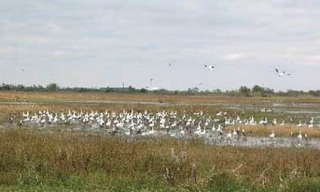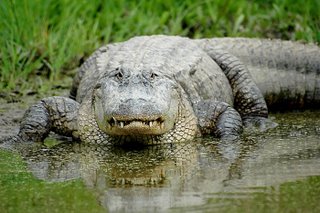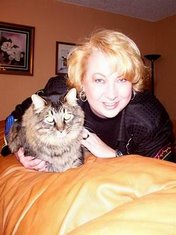 Holli, one of my fabulous new friends from National, asked on my blog yesterday exactly what a bayou looks like. The fact is, they all look a bit different. The word bayou originated from the Louisiana French word "bayuk" which means small stream. So essentially, any offshoot of another larger body of water (lake, ocean, river, etc.) is a bayou.
Holli, one of my fabulous new friends from National, asked on my blog yesterday exactly what a bayou looks like. The fact is, they all look a bit different. The word bayou originated from the Louisiana French word "bayuk" which means small stream. So essentially, any offshoot of another larger body of water (lake, ocean, river, etc.) is a bayou.Depending on where you are in Louisiana, the bayous and the surrounding areas look very different. This first picture is one of a bayou in the Atchafalaya basin. Notice the dense foilage and cypress trees. Some areas of this type of bayou are so thick with trees and such that standing in the middle of it, you can't see a sliver of sunlight.

The picture above is the second kind of bayou surroundings, called a marsh. This picture was taken in Cameron, where my parent's camp was located. There are some trees, but very few and they are spotty at best across the marsh land. Mostly, the marsh is tall weedy type grasses with low-lying water areas. You can see for miles across the marsh. These are also often referred to as coastal wetlands and all sorts of conservation efforts are always underway to keep them from disappearing.

To the left, you'll see the king of the bayou - the alligator. Alligators are fierce-looking creatures and it's not a wasted look. When I was a kid, however, alligators behaved more like snakes in that if they heard you coming, they ran away. The recent attacks in Florida make me wonder what's going on. My guess is that man is encroaching too much on the alligator's territory and the alligators are fighting back. Plus with the increase of residential and commerical centers so close to waterways, the food supply is diminished. I guess the alligator think - "no more fish.........then I'll just snag a jogger." The only alligator attack I was ever aware of growing up was a mother protecting a nest of eggs.

This "little" guy to the right is a nutria. They are rodents that inhabit the wetlands and make trails through the marsh that are destroying the wetlands by allowing water to rush further into the grassy areas. This guy will weigh 20 pounds when fully grown - larger than your average housecat.
So this concludes the Louisiana Bayou Tour, featuring your host, Jana DeLeon.
Thanks for asking the question, Holli. I may bore the heck out of readers, but I had a fun time putting this together!



10 comments:
thanks, Jana. I found it very interesting.
Now, when are you going to dish on your big news?
Ally
Hi Ally - glad you're back from the land of diapers! I asked permission to share last night, but can't check my personal email from work. So the soonest I can post will be tomorrow. I wanted to make sure everything was for "public consumption" before I starting blabbing in print. :)
Thanks for the bayou pictures! I might have to pick your brain some day if I ever work on my Louisiana shapeshifter story. :)
Hi Tori - Louisiana shapeshifter, huh? Sounds like a great idea!
This is near and dear to my heart as some one who's part-Coonass. My grandfather was full Cajun raised in Kenner, LA. I was weaned on Jambayla and Gumbo.
Jaye - I had no idea you were part Coon-Ass, but that's cool! I have the distinction of being raised there but not being CA at all. I am actually German-Scot. Oh well, I still love the food!
I think if you're raised there you're Coonass by association.
Jaye - LOL, probably so. My husband would say I've got the "tendencies" anyway. Of course, anyone who reads my work sees that immediately.
Jana,
The pictures and description are great! Thank you. Now, what is this about a secret???
Holli - you already know the "secret" but I've been told it's not for public knowledge right now, so I have to keep it out of print.
Sorry to everyone else for teasing, but you know how this industry is. :)
Post a Comment